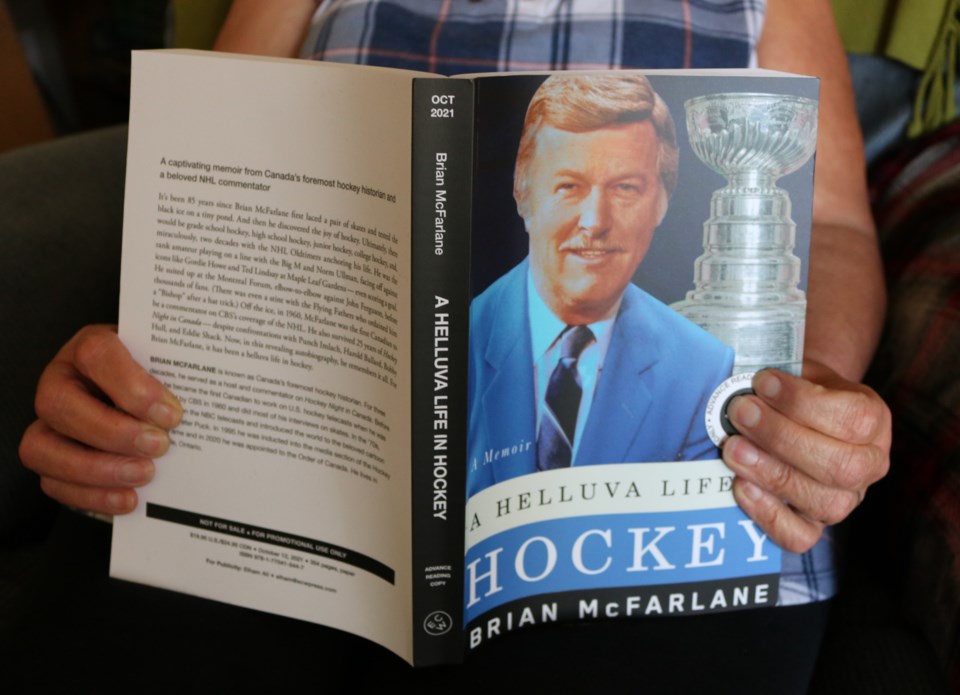That channel was likely CBC, and while options were limited to whatever was on at a particular time, it at least included Hockey Night In Canada every Saturday evening.
With the exception of combining if harvest was running late and the National Hockey League season started, or seeding when playoffs were on, watching games Saturday evening were about as Saskatchewan thing to do as there was. I suspect most people of a certain age – 50-to-70 – will remember watching in their youth, and it was certainly good memories of time spent with my father.
Since HNIC was part of my youth I of course recall Brian McFarlane who began on the show in 1964 when I was only four, but was around as I more fully became immersed in the sport, the NHL and the show as I grew older.
So when the chance came along to read a review copy his memoir ‘A Helluva Life In Hockey’ recently released by ECW Press, I was more than a little interested.
Of course McFarlane is not new to authorship, with a long list of titles to his name.
“I’m trying to reach 100. My wife tells me I’m getting close,” he said in a recent telephone interview. He added he has some “10 books on the computer” just waiting to be published.
In fact, he said “as you called I was searching out an agent,” adding he was leaning toward one in the United States because “hockey is growing in popularity there.”
The book is a rambling story with McFarlane letting us into his life growing up and throughout a hockey broadcast career when he rubbed shoulders with the greats of a now bygone era; Johnny Bower, Maurice Richard, Gordie Howe, Ted Lindsay and dozens of others. Many of course are mentioned in the book, often through the remembrance of a story shared with McFarlane.
Younger readers are likely to wonder who most mentioned are, and therefore enjoy the read less, but at 61 it was a series of bite-sized insights into players, most of whom I still recall well.
McFarlane does tend to wander through the book a bit. He can jump from one player to another story with such a thin segue it is really nonexistent, which will be disquieting for some.
But, along the way McFarlane mentions a coffee shop in Florida he frequents, and I could quite imagine sharing a cup and letting the conversation ebb and flow in a free flowing discussion of hockey past. With that in my mind the book was an enjoyable romp through the varied life of the author.
Along the way there were a number of really fun and a few startling gems.
The fun ones include McFarlane telling the story of the creation of Peter Puck. Peter was the impish animated hockey puck that told stories of the game during HNIC intermissions, a creation loved by youngsters like myself.
“I was with NBC TV,” he said, adding he actually sent material to Hanna-Barbera detailing the rules and history of hockey to aid them in creating the character and initial shows. The idea initially in 1974 “was to educate a lot of American viewers about the fundamentals of the game and the history of the game.”
Then there was the Scotiabank Hockey College McFarlane was part of launching. It was another memory ignited as I recall the magazine on the sport you went to the local branch to pick up.
“That’s one thing I was very proud of,” said McFarlane, who added when he first approached Scotiabank he found the then Marketing Director “happened to be Dad’s branch manager” at one time, and that connection factored largely in him having the opportunity to pitch his idea.
And the startling gem included learning McFarlane’s father Leslie who wrote 21 Hardy Boys novels under the pseudonym Franklin W. Dixon. He was paid only $85-100 per book, with no royalties coming his way.
Much like HNIC reading the Hardy Boys book was a rather common thing for a young boy in Saskatchewan in the 1970s, and I devoured a bunch, several found in my grandparents’ basement in an small book cupboard – which is still with me. They had belonged to my dad when he was young.
McFarlane said his father was never a fan of his work on the books that would sell tens of millions of copies over the decades.
“He didn’t want anybody to be aware of it,” he said, adding his father kept taking the assignment to write another volume “simply for the hundred bucks.”
While his son appreciates “they got a lot of kids hooked on reading” the elder McFarlane saw a book as “coal in the furnace for the winter.
“He knew it wasn’t great literature. I guess we all knew that, but it got kids hooked on reading.”
Or there were the memories of Bobby Hull, a star of the Chicago Blackhawks, with a slap shot which remains legendary. McFarlane credits Hull for his hockey, but also writes of the evidence he abused his wives. That McFarlane was willing to do that points to his willingness to tell the full story when warranted.
“I just do what I think is right and know about,” he told me.
McFarlane said the new book is actually his third memoir and he was looking to inject more of himself into it by relating the stories he heard and collected from those in hockey over the decades.
“I hope it works. The publisher seems high on it,” he said.
From the perspective of this writer it is a book that will be a great stocking stuffer for the grandparent who loves the game, as it takes the reader back to the days of their youth.

